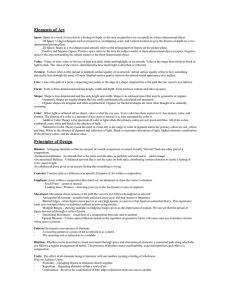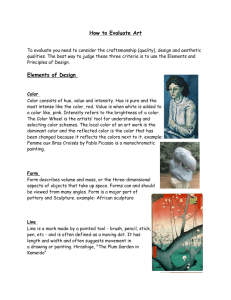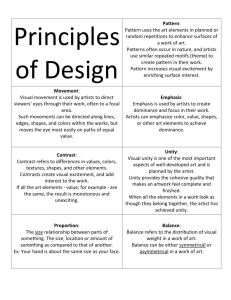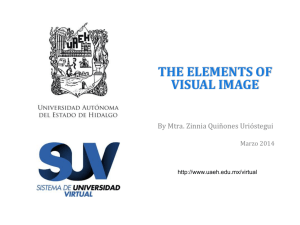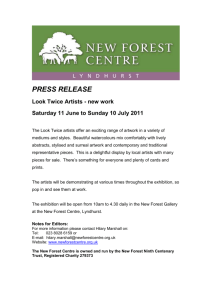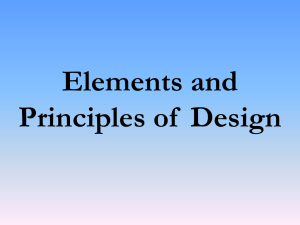Visual Arts - PS 105 Curriculum
advertisement
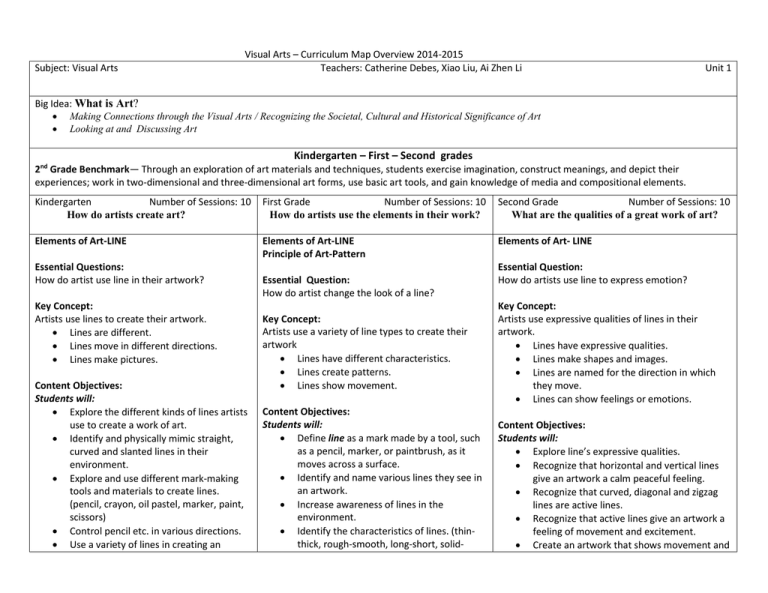
Subject: Visual Arts Visual Arts – Curriculum Map Overview 2014-2015 Teachers: Catherine Debes, Xiao Liu, Ai Zhen Li Unit 1 Big Idea: What is Art? Making Connections through the Visual Arts / Recognizing the Societal, Cultural and Historical Significance of Art Looking at and Discussing Art Kindergarten – First – Second grades 2nd Grade Benchmark— Through an exploration of art materials and techniques, students exercise imagination, construct meanings, and depict their experiences; work in two-dimensional and three-dimensional art forms, use basic art tools, and gain knowledge of media and compositional elements. Kindergarten Number of Sessions: 10 How do artists create art? First Grade Number of Sessions: 10 How do artists use the elements in their work? Second Grade Number of Sessions: 10 What are the qualities of a great work of art? Elements of Art-LINE Elements of Art-LINE Principle of Art-Pattern Elements of Art- LINE Essential Questions: How do artist use line in their artwork? Key Concept: Artists use lines to create their artwork. Lines are different. Lines move in different directions. Lines make pictures. Content Objectives: Students will: Explore the different kinds of lines artists use to create a work of art. Identify and physically mimic straight, curved and slanted lines in their environment. Explore and use different mark-making tools and materials to create lines. (pencil, crayon, oil pastel, marker, paint, scissors) Control pencil etc. in various directions. Use a variety of lines in creating an Essential Question: How do artist change the look of a line? Key Concept: Artists use a variety of line types to create their artwork Lines have different characteristics. Lines create patterns. Lines show movement. Content Objectives: Students will: Define line as a mark made by a tool, such as a pencil, marker, or paintbrush, as it moves across a surface. Identify and name various lines they see in an artwork. Increase awareness of lines in the environment. Identify the characteristics of lines. (thinthick, rough-smooth, long-short, solid- Essential Question: How do artists use line to express emotion? Key Concept: Artists use expressive qualities of lines in their artwork. Lines have expressive qualities. Lines make shapes and images. Lines are named for the direction in which they move. Lines can show feelings or emotions. Content Objectives: Students will: Explore line’s expressive qualities. Recognize that horizontal and vertical lines give an artwork a calm peaceful feeling. Recognize that curved, diagonal and zigzag lines are active lines. Recognize that active lines give an artwork a feeling of movement and excitement. Create an artwork that shows movement and Visual Arts – Curriculum Map Overview 2014-2015 artwork. broken) Identify and describe the different lines Describe the different ways artists change they used in their artwork. lines. Experiment with and use a variety of I can identify and name different types of lines. materials to create different characteristics I can show how lines move in different directions. of line. I can scribble freely. Know that line direction creates I can draw, paint, and cut a variety of lines. movements. Create line patterns. Vocabulary: Create art using line variation and scribble movement. line straight I can identify and name different types of lines. curved I can make and identify the characteristics of line. slanted I can make line patterns. diagonal I can group marks and show line movement vertical I can change the look of a line. horizontal spiral Vocabulary: zigzag line broken straight zigzag Elements of Art –SHAPE curved looped Essential Question spiral How do artist use shape in their artwork? vertical horizontal Key concept: diagonal Artists use different shapes in their artwork. dotted Lines outline shapes. solid-broken thin-thick Objectives: rough-smooth Students will: long-short Understand that artworks can contain pattern shapes. repetition Identify and name different geometric shapes used by artists and in the expression. Describe the lines they used to show an emotion or sense of movement. I can name the direction of lines. I can create shapes and images using lines. I can use lines to show emotion and expression. Vocabulary: horizontal vertical diagonal zigzag curved active lines calm lines Elements of Art- SHAPE Key Concept: Artists use shape to express ideas. Essential Question: How do artists use shapes to express ideas? Content Objectives: Students will: Describe the lines used to make shapes. Examine and discuss the use of geometric and organic shapes in art masterpieces and other cultures. Identify and use geometric and organic shapes in their artwork. Recognize abstract patterns of geometric shapes. Understand the concept of depth by repeating and overlapping shapes of different environment. Draw, paint, and cut different shapes. Create artwork using geometric shape. I can name different shapes. I can draw shapes. I can paint shapes. I can cut and glue shapes. Vocabulary shape geometric bend Elements of Art—COLOR Essential Question: Why do artists choose certain colors? Key concept: Artists use color in their artwork. Artists use colors from real life and from their imagination. Colors have names. Colors help us to identify things. Content Objectives: Students will: Recognize and name colors in various artworks and in the environment. Identify primary and secondary colors. Mix colors. Create an artwork using primary and secondary colors. I can recognize and name colors I can identify primary and secondary colors I can mix colors Visual Arts – Curriculum Map Overview 2014-2015 Elements of Art- SHAPE Essential Question: Why do artists use certain shapes? Key concept: Artists use organic and geometric shapes in their artwork. Lines outline shapes. Shapes build images. sizes Combine shapes to express an idea. I can name the lines used to create a shape. I can identify the shapes used in art masterpieces and other cultures. I can describe how artists use shape to create abstract images of real objects. I can arrange shapes to make an abstract and/or realistic design expressing personal ideas. Content Objectives Students will: Understand that all objects consist of shapes. Identify geometric and organic (free-form) shapes in artwork and the environment. Understand that geometric shapes have a name, are used in math and can be measured. Understand that organic shapes are shapes that are usually created by curved lines and represent nature. For example, people, animals, plants, flowers. Increase awareness of how shapes are used together to build images. Create artwork using both geometric and organic shapes. Vocabulary: abstract realistic geometric shape organic / free-form shape depth overlap I can identify and name different shapes. I understand the difference between geometric and organic shapes. I can draw, cut and glue different shapes. I can create images using shape. Content Objectives: Name and recognize colors in an artwork Understand meanings of different colors Understand artist’s choice of colors Create an artwork using colors to express mood/emotion Vocabulary shape I can understand colors have meanings. Elements of Art- Color Essential Question: How do artists use colors to express ideas, moods, and emotions? Key Concept: Artists use color to express ideas, moods, and emotions Vocabulary: Primary color Secondary color Visual Arts – Curriculum Map Overview 2014-2015 geometric organic free-form I can understand artist chooses certain colors to convey meanings. I can create an artwork with colors to express mood/emotion. Elements of Art—Color Essential Question: Why do artists choose warm and/or cool colors? Key concept: Artists use warm and cool colors to create artwork. Vocabulary: Color schemes Aesthetic Mood Emotion Content Objectives: Recognize and name warm and cool colors in an artwork Identify warm/cool colors in real life Create an artwork using warm/cool colors I can recognize and name warm and cool color. I can create an artwork using warm/cool colors. Vocabulary: Warm color Cool color Performance Task: Performance Task: Performance Task: Create a work of art that demonstrates: Experimentation with various markmaking media Use of varied lines, shapes, and colors Create a work of art that demonstrates: Use of various mark-making media Use of varied lines Use of geometric and organic shapes Use of color combination Create a work of art that demonstrates: Use mark-making media to express ideas, moods, and emotions Use the combination of lines, shapes, and colors to express feeling Subject: Visual Arts Visual Arts – Curriculum Map Overview 2014-2015 Teachers: Catherine Debes, Xiao Liu, Ai Zhen Li Unit 1 Big Idea: What is Art? Making Connections through the Visual Arts / Recognizing the Societal, Cultural and Historical Significance of Art Looking at and Discussing Art/ Making Inferences Based Visual Evidence Third – Fourth – Fifth grades th 5 Grade Benchmark— Students begin sequential unit projects; extend knowledge of art media and compositional and design elements; choose new ways of using familiar tools and materials, and deepen imaginative capacities, observational and expressive skills. Third Grade Number of Sessions: 10 Why do artists create art? Fourth Grade Number of Sessions: 10 Why do artists create art? Essential Question: How do artists use a variety of lines to create visual interest? Essential Questions: Essential Questions: How do artists use contour lines and structural lines How do artists use proportion to show how objects to create proportion? relate to one another in size? Key Concept: Artists use a variety of lines to create visual interest. Lines can express a mood or feeling. Line variety creates visual interest. Key Concept: Artists create proportion by drawing interior structure within a contour line. Key Concept: Artists use proportion to show how objects relate to one another in size. Objectives: Students will be able to… Identify structural lines within contour lines. Differentiate between structural lines and contour lines. Understand the purpose of using contour lines/structural lines. Use contour lines and structural lines to create an artwork with accurate size relationships. Objectives: Students will be able to… Identify the use of proportion in art. Discuss and validate good examples of proportion Identify well proportion people. Identify the use of scale by artists. Create an artwork in proportion. Objectives: Students will: Identify and use a variety of lines in creating art with visual interest. Observe the variations found in the outside edges or contour of objects. Draw contour lines. Use structural lines to show the interior features of objects. Produce a complex line design. I can create line variety. I can create mood or feeling with lines. I can create visual interest with lines. I can draw contour lines. I can identify structural lines and contour lines in an artwork. I can understand the difference between contour and structural lines. I can use contour lines and structural lines to create Fifth Grade Number of Sessions: 10 Why do artists create art? I can identify the use of proportion in art. I can discuss and validate good examples of proportion. I can identify the use of scale by artists. I can identify well proportion people. I can create an artwork in proportion. I can apply structural lines. Visual Arts – Curriculum Map Overview 2014-2015 an artwork with accurate size relationships. Vocabulary: Contour Structural lines Variety The principle of art-proportion Key concept: Artists create proportion using contour lines. Content Objectives: Students will be able to… • Identify contour lines. • Recognize structural lines. • Draw contour lines • Use structural lines to show interior features of objects. • Create a contour line drawing. I can identify contour lines. I can recognize structural lines. I can draw contour lines. I can use structural lines to show interior features of objects. I can create line variety. Vocabulary: Gesture drawing Expression Figure/facial expression. Vocabulary: Contour line structural line proportion accurate size size relationship Vocabulary: Scale Proportion Exaggeration distortion Performance Task: Visual Arts – Curriculum Map Overview 2014-2015 Performance Task: Create a series of artwork that demonstrate: Proportion Variety Evidence of self-expression Observation of detail Interpret artwork by providing evidence to support his/her assertions; Reflect on the process of making art. Create a series of artwork that demonstrate: Proportion Variety Evidence of self-expression Observation of detail Interpret artwork by providing evidence to support his/her assertions; Reflect on the process of making art. Performance Task: Create a series of artwork that demonstrate: Proportion Variety Evidence of self-expression Observation of detail Interpret artwork by providing evidence to support his/her assertions; Reflect on the process of making art. Grades K-5 Representation The “what” of teaching and learning… (What format will the teacher use to present content?) Audio Smartboard Discussion/Questioning Videos Visual Texts Charts Reproductions Arts-related literature Kinesthetic Art making (drawing, painting, collage making, sculpturing, print making, media technology, and two dimensional applied design) Technology Scholastic Arts Visual Art websites (Brainpop Jr., Pinterest, artyfactory) Powerpoint presentation Action and Expression The ‘how’ of teaching and learning… (How will you present the content? Through…) Visual reproduction Videos/powerpoint presentation Arts-related literature Charts/visual vocabulary Observation Demonstration of techniques Cultural institutions Online resources Awareness of careers in visual arts Engagement The ‘why’ of teaching and learning and learning… (What activities will students do to demonstrate their learning?) Art making Looking at and discussing art Developing visual arts vocabulary Reading and writing about art Problem solving: interpreting and analyzing art Making connections (recognizing the societal, cultural, and historical significance of art; connecting art to other disciplines, observing and interpreting the world) Visual Arts – Curriculum Map Overview 2014-2015 Resources: Websites: http://schools.nyc.gov/offices/teachlearn/arts/blueprint.html http://www.p12.nysed.gov/ciai/arts/pub/artlearn.pdf http://www.artsandactivities.com/ http://www.schoolartsdigital.com/read/account_titles/214208 http://www.davisart.com/Promotions/SchoolArts/Default.aspx Books: SRA Art Connections The series of getting to know the world’s greatest artists Crystal Productions


